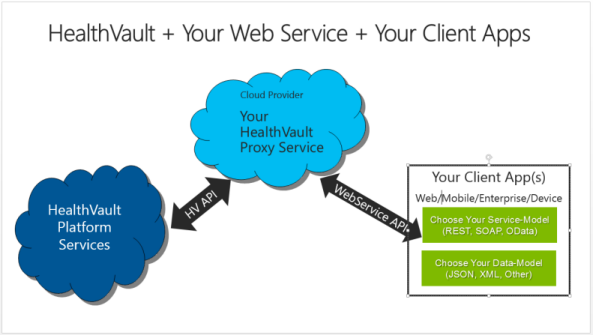Initial commit of .NET samples, including samples ported from code.msdn.microsoft.com and a new sample which demonstrates use of the ActionPlans preview. |
||
|---|---|---|
| .. | ||
| C# | ||
| images | ||
| README.md | ||
README.md
Introduction
Cloud hosted services such as HealthVault, Windows Azure, Office365, Dynamics Online, and others provide a great canvas upon which to compose both consumer and enterprise solutions. This code-sample, with corresponding documentation, illustrates the use of a Windows Azure hosted web-service to encapsulate specific HealthVault platform services and subsequently exposes those services to a variety of client application types. The concept isolates HealthVault SDK dependencies and thus frees client-apps to work with whatever service-model (e.g. SOAP, REST) and data-model (e.g. XML, JSON) desired.
The HealthVault Proxy Service exposes three primary service-interfaces for client apps. These interfaces correspond to HealthVault feature areas. Specifically, Patient Connect, Get/Put Things, and DOPU. Learn more about HealthVault solution architectures at the Health Team Blog.
Building the Sample
The attached source file is a Visual Studio 2012 solution. You will also need the .NET HealthVault SDK. Complete development, build/test, and deployment instructions are provided via this blog post.
Description
Example Service/Client Interface. The following code-snippet illustrates both the server and client interface implementation of the HealthVault "Patient Connect" workflow. This workflow is used to establish application authorization for a HealthVault user account. Similar service-contracts are provided for Data Access and for the "Drop-Off and Pick-Up" information exchange workflow.
// Patient Connect Service-Interface
[ServiceContract]
public interface IHVConnect
{
[OperationContract]
ConnectResponse CreateConnection(ConnectRequest request);
[OperationContract]
ValidatedConnectionsResponse GetValidatedConnections(ValidatedConnectionsRequest request);
[OperationContract]
DeletePendingConnectionResponse DeletePendingConnection(DeletePendingConnectionRequest request);
[OperationContract]
RevokeApplicationConnectionResponse RevokeApplicationConnection(RevokeApplicationConnectionRequest request);
}
// Patient Connect Client Implementation
static void TestCreateConnection(string token, ref PatientRecord record)
{
try
{
HVConnect.HVConnectClient client = new HVConnect.HVConnectClient();
HVConnect.ConnectRequest request = new HVConnect.ConnectRequest();
request.Token = token;
request.LocalPersonName = record.PatientName;
request.LocalRecordId = record.PatientId;
request.SecretQuestion = record.SecretQuestion;
request.SecretAnswer = record.SecretAnswer;
HVConnect.ConnectResponse response = client.CreateConnection(request);
if (response.Success)
{
record.ConnectCode = response.ConnectionCode;
record.PickUpURL = response.PickupUrl;
Console.WriteLine("Connection Code = {0}\n", response.ConnectionCode);
Console.WriteLine("PickupUrl = {0}\n", response.PickupUrl);
}
else
Console.WriteLine("Error = {0}\n", response.Message);
}
catch (Exception ex)
{
Console.WriteLine("Exception : CreateConnection : {0}", ex.Message);
return;
}
}
Source Files
See HVProxyTest.cs for client-side usage scenarios for each service interface.
